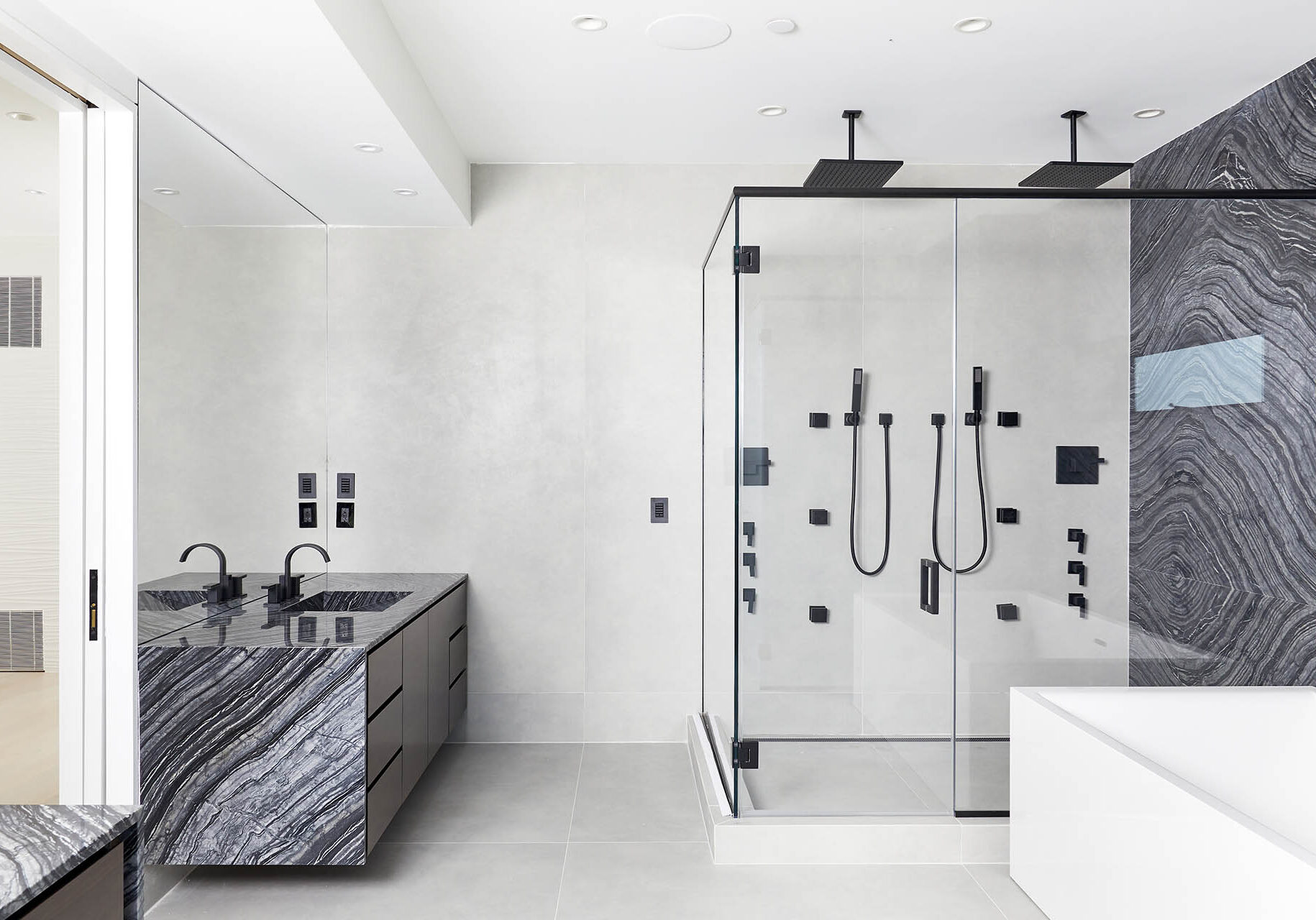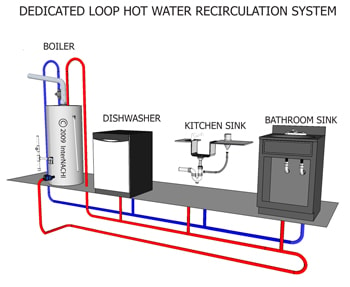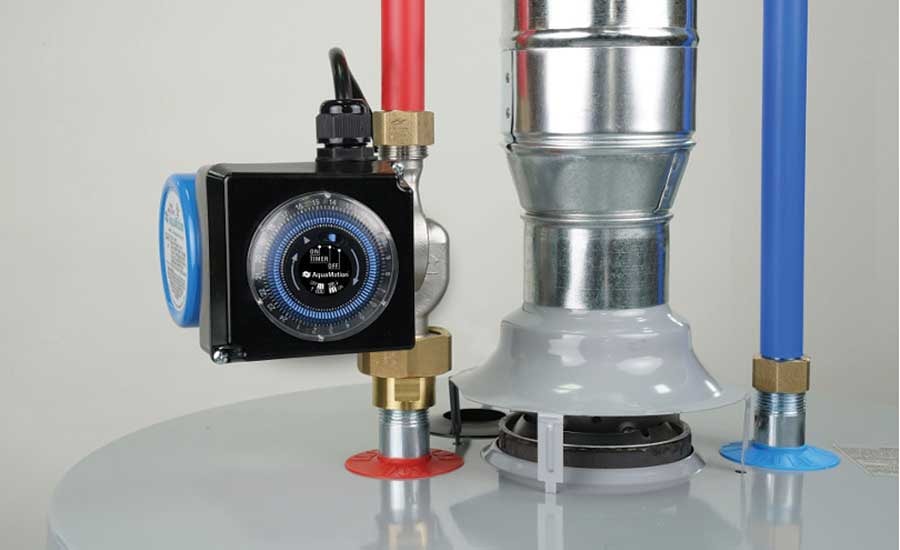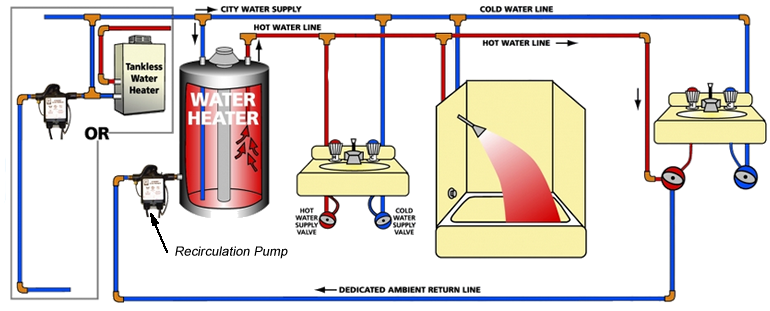Upgrade Efficiency and Convenience with a Hot Water Recirculating System
In high-end residential projects, combining luxury with functionality is essential, and a hot water recirculating system integrated with a hot water heater can meet this demand. Hot water recirculation systems solve the problem of delayed hot water at the point of use (such as shower, sink, faucet, etc.) due to water temperature drops in hot…
Morgan Poulos Keating, PE
July 2, 2024
11 mins read

In high-end residential projects, combining luxury with functionality is essential, and a hot water recirculating system integrated with a hot water heater can meet this demand. Hot water recirculation systems solve the problem of delayed hot water at the point of use (such as shower, sink, faucet, etc.) due to water temperature drops in hot water lines during periods of non-use. By providing instant hot water at the tap, these systems reduce water waste and enhance overall comfort and convenience. This combination means seamless design solutions that enhance the living experience for homeowners and meet sustainability goals, making it a smart investment for any high-end residential project.

Hot Water Recirculating Systems
The design of a hot water recirculating system can vary, but it generally includes a pump, a return line, and a series of valves and sensors. The pump is the heart of the system, responsible for circulating water from the water heater through the hot water pipes and back again via a dedicated return line. In homes without a dedicated return line, the system can use the cold water pipes as a return path. Advanced systems may also include timers, thermostats, or motion sensors to control when the pump operates, optimizing energy use and ensuring hot water availability based on the household’s needs.
Hot Water Recirculating Pump
The hot water recirculating pump is the backbone of any efficient hot water delivery system, moving water through the hot water pipe to provide hot water on demand.
The hot water recirculating pump is essential for ensuring that hot water is readily available at every tap in a home. By continuously or on-demand circulating water from the water heater through the hot water pipes and back, the pump maintains a constant flow of hot water. This eliminates the need to wait for hot water to reach the fixture, reducing water waste and enhancing convenience. The pump operates by pushing water through the pipes, ensuring hot water is always available when needed, thereby contributing to both energy and water conservation.
Hot water recirculating pumps come with various features that enhance their functionality and efficiency.
- Timers and sensors: Many pumps are equipped with timers or sensors to optimize their operation. Timers allow homeowners to schedule the pump’s activity during peak usage times, while sensors can detect when hot water is needed and activate the pump accordingly, ensuring efficient use of energy.
- Thermostatic controls: Some pumps include thermostatic controls that monitor water temperature, maintaining it within a desired range. This feature ensures that hot water is available when needed without wasting energy, as the pump operates only when necessary to keep the water at the set temperature.
- Quiet operation: Modern pumps are designed to operate quietly, minimizing noise disruption in the home. This is particularly important in residential settings where a quiet setting is valued.
Depending on the type of recirculation system, check valves are often used where the dedicated return of the hot loop integrates back to the cool water supply either at the water heater or the sink furthest away from it. A check valve ensures that water flows in the intended direction preventing hot water from flowing on the cold line and vice-versa due to pressure differentials in pipes while water is flowing.

Types of Hot Water Recirculating Systems
Hot water recirculating systems come in various designs to meet different needs and preferences. Each type offers unique advantages and can be chosen based on the specific requirements of the home, stage of the project and the preferences of the homeowners.
Traditional Systems
Traditional hot water recirculating systems include a recirculation pump at the hot water heater and a dedicated return line that loops the hot water back to the water heater.
- Continuous circulation: Traditional systems operate continuously, maintaining a constant flow of hot water through the pipe loop formed by the hot water supply and return. This eliminates the wait time for hot water, providing instant access at all fixtures.
- Dedicated return line: A separate return line is used to send the cooled water back to the heater for reheating. This setup is usually easier to incorporate in new constructions where the plumbing layout can be designed accordingly.
- Energy usage: While providing instant hot water, traditional systems can be less energy-efficient if not properly managed. Incorporating timers or thermostats can help optimize energy usage by controlling when the pump operates.

Instant Systems
Instant hot water recirculating systems are designed to provide immediate hot water without the need for a dedicated return line. In instant systems, the pump is typically installed on the hot water line at the sink located furthest from the water heater. Warm water is recirculated back through the cold water pipes (integrated loop system) until hot water has arrived. In an integrated loop system, the process raises the temperature of the cold water slightly as it returns to the usual cold temperature in a short time. These systems are ideal for retrofitting existing homes where installing new plumbing lines may not be feasible.
- Point-of-use installation: Instant systems are often installed at the farthest fixture from the water heater, using the existing cold water line as a return path. This setup allows for easy installation without major plumbing alterations.
- Temperature-based activation: The pump activates when a drop in temperature is detected, circulating water until the desired temperature is reached. Once the hot water arrives, the pump shuts off, conserving energy.

On-Demand Systems
On-demand hot water recirculating systems offer a highly efficient and user-controlled solution for providing hot water exactly when needed. These systems are activated manually or by motion sensors, ensuring hot water is available only when required.
- Manual or sensor activation: On-demand systems can be activated manually via a switch or button, or automatically through motion sensors placed near fixtures. This ensures that the pump operates only when hot water is needed.
- Energy efficiency: By operating only when activated, on-demand systems are highly energy-efficient. They eliminate the continuous energy consumption associated with traditional systems, reducing both energy and water waste.
- User control: These systems offer homeowners greater control over their hot water usage, making them ideal for those who prioritize energy conservation and cost savings. The ability to activate the system only when necessary ensures optimal efficiency.
Whether opting for the continuous flow of traditional systems, the retrofit-friendly design of instant systems, or the energy-saving features of on-demand systems, homeowners can choose the solution that best fits their lifestyle and needs.
Benefits of a Hot Water Recirculating System
Installing a hot water recirculating system in a home offers numerous advantages that enhance convenience, efficiency, and cost-effectiveness. Here are the primary benefits:
Quicker Hot Water
One of the most significant benefits of a hot water recirculating system is the immediate access to hot water at every fixture.
- Immediate availability: Hot water is delivered almost instantly to showers, faucets, and appliances, eliminating the typical wait time.
- Improved convenience: This immediate availability enhances daily routines, providing a more comfortable and efficient experience for homeowners.
- Reduced water waste: By eliminating the need to run the tap while waiting for hot water, these systems significantly reduce the amount of water wasted.
Energy Efficiency and Water Conservation
Implementing a hot water recirculating pump can lead to significant energy efficiency and cost savings over time.
- Energy consumption: While the pump itself uses electricity, it can lead to overall energy savings by reducing the amount of water heated unnecessarily. The efficient circulation of hot water means the water heater operates less frequently, saving energy.
- Eco-friendly: These systems save water (up to 10,000 gallons per year) by reducing or eliminating the amount of time that water is running while waiting for hot water. The overall reduction in water and energy usage contributes to a more sustainable and environmentally friendly home.
Cost Savings
The long-term financial benefits of installing a hot water recirculating system can be substantial.
- Lower utility bills: With reduced water waste and optimized energy use, homeowners can see a decrease in both water and energy bills.
- Increased appliance efficiency: By providing hot water more quickly, the system can help extend the lifespan of water heaters and other appliances by reducing their workload.
- Investment return: Although there is an initial cost for installation, the savings on utility bills over time can offset this expense, making it a cost-effective solution in the long run.
Factors to Consider Before Installing a Hot Water Recirculating System
Before installing a hot water recirculating system, it’s important to evaluate several key factors to ensure it meets your needs and expectations. Here are the primary considerations:
Cost – Understanding the financial aspects of installing a hot water recirculating system is crucial.
- Initial investment: The upfront cost includes the price of the pump, any additional components, and installation fees. These costs can vary depending on the type of system and the complexity of the installation.
- Long-term savings: While the initial expense can be significant, the potential savings on water and energy bills over time can offset these costs. It’s important to consider the payback period and long-term financial benefits.
- Potential rebates: In some areas, there may be rebates or incentives available for installing energy-efficient systems, which can help reduce the overall cost.
Installation Process – The complexity and requirements of the installation process should be carefully considered.
- Plumbing layout: The existing plumbing setup in your home will influence the ease of installation. Homes with dedicated return lines can facilitate a simpler installation process, while retrofitting older homes may require more extensive work.
- Professional installation: Depending on the system and your plumbing skills, you may need to hire a professional for the installation. Professional installation ensures that the system is correctly installed and functioning optimally.
- Time and disruption: Consider the time required for installation and any potential disruptions to your household during the process. Planning for these factors can help minimize inconvenience.
Maintenance – Regular maintenance is essential to keep the system running efficiently and prolong its lifespan.
- Routine checks: Regular inspections of the pump, valves, and other components are necessary to ensure they are in good working condition. Checking for leaks and unusual noises can help detect issues early.
- Cleaning and upkeep: Periodic cleaning of the pump and removing any mineral buildup or debris is crucial for maintaining efficiency. Ensuring that the system remains clean and free of obstructions can prevent malfunctions.

Is Hot Water Recirculation Right For Your Project?
Determining whether hot water recirculation is suitable for your project involves evaluating various factors, such as the specific needs of the property, the benefits of the system, and the expertise required for its installation and maintenance. Here are some project considerations:
- Property size and layout: Large homes or properties with distant fixtures can benefit significantly from hot water recirculation, reducing the wait time for hot water and minimizing water waste.
- Water and energy savings: Assess the potential savings in water and energy costs. Homes in areas with high water costs or where water conservation is a priority will see more immediate benefits.
- User convenience: Consider the convenience of having instant hot water. For homes where comfort and efficiency are top priorities, a recirculating system can greatly enhance the living experience.
- Installation feasibility: Evaluate the feasibility of installation based on the existing plumbing system. Retrofitting an older home may require more extensive modifications compared to new constructions where the system can be planned from the outset.
- Budget: Factor in the initial investment versus long-term savings. While the upfront costs can be significant, the savings on utility bills and the added convenience can justify the expenditure over time.
DAE’s Expertise
At DAE, we bring a wealth of expertise in designing and implementing hot water recirculation systems tailored to the unique requirements of high-end residential and commercial projects. Our team meticulously analyzes each project’s specific needs, ensuring the system selected optimizes performance, maximizing energy efficiency and reducing water waste.
Whether you are embarking on a new construction or retrofitting an existing property, our engineering team will ensure that your system functions optimally from day one. With DAE, you are assured a high-performing, sustainable, and convenient hot water delivery system, enhancing the overall value and comfort of the final space.